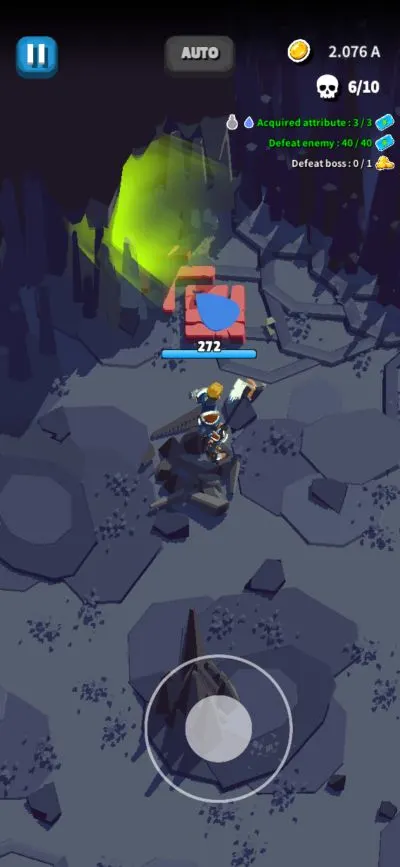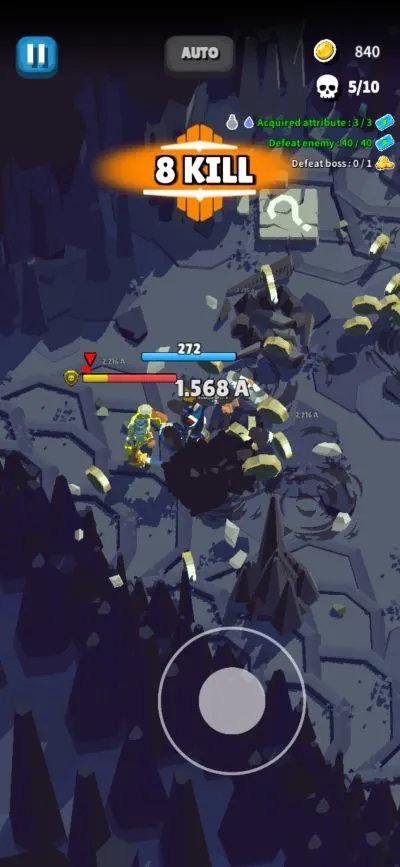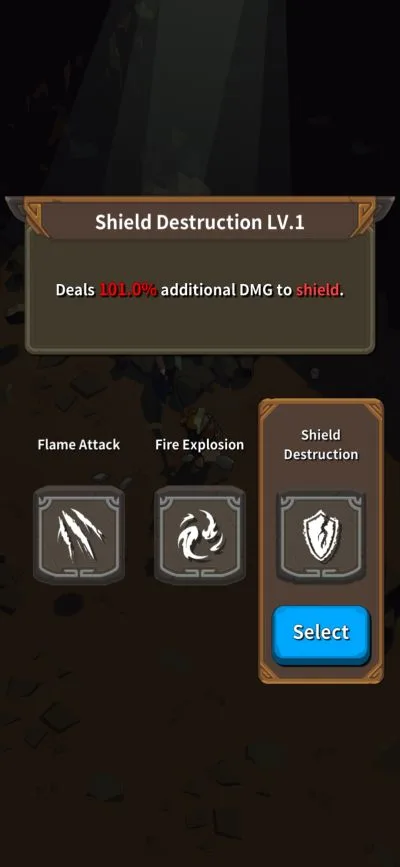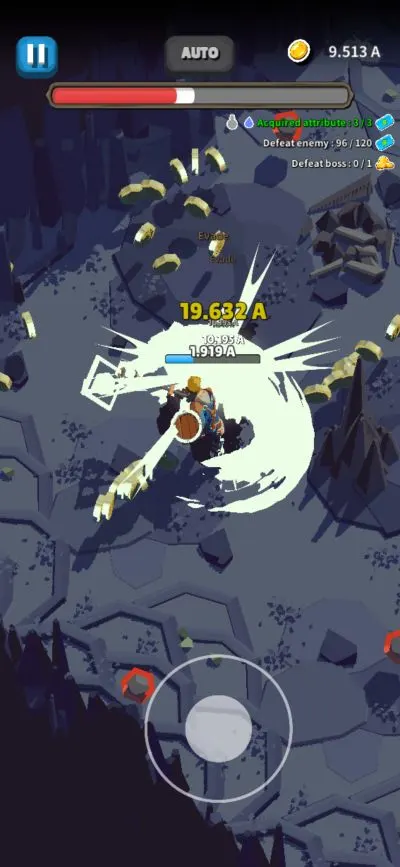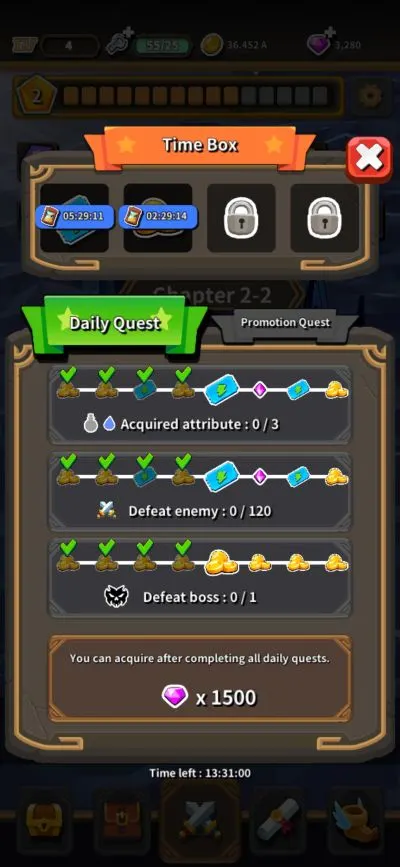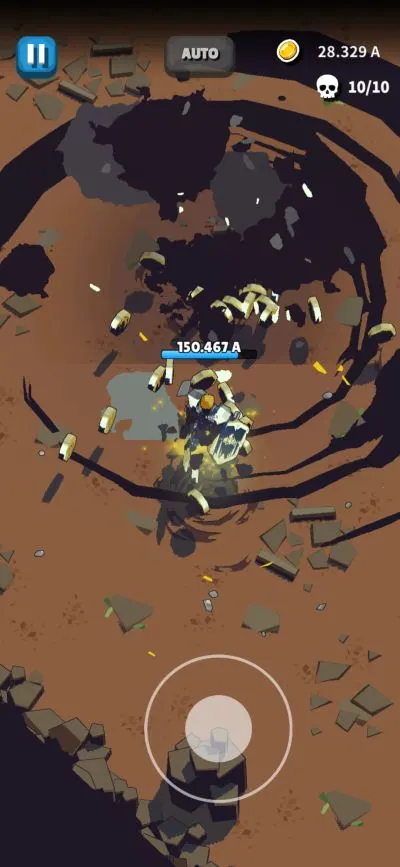Demigods — aberrations in the eyes of the divine. As the offspring of gods and mortals, demigods often possess some of the powers that their divine kin wield while at the same time sharing the weaknesses of those from their human sides. In this world, demigods are looked down upon — beings that shouldn’t be, powerless and unworthy. But some demigods have risen to the challenge, to show the cruel divines that they aren’t to be trifled with.
Obliging the cocky demigods, the gods have erected massive dungeons filled with twists, turns, and legions of their creations. It is in these dungeons where only true might is tested. Demigods have fallen here many times and among them might just be you. As one of the demigods that have stepped forth to the challenge, will you fall like the others into eternal abyss or will you conquer the Dungeon of Gods?
From the makers of Lucid Adventure, Evil Hunter Tycoon, Sword Master Story, and ZIO and the Magic Scrolls, South Korean developer Super Planet is back with a brutal, action-packed, and difficult dungeon crawler: Dungeon of Gods. Similar to other dungeon crawlers available today such as Nonstop Knight, Dungeon Quest, Soul Knight, Otherworld Legends, and Mighty Quest for Epic Loot, Dungeon of Gods brings a refreshing, new spin to the dungeon crawler genre.
To the unfamiliar, a dungeon crawler involves… well… crawling through dungeons (figuratively, of course, since your character is usually bipedal). That’s the short answer. The long answer is that you have a hero, and this hero has to go through a series of rooms, slaying monsters and looting treasure chests as they go, all the way until they reach the boss. When the boss is slain, they may drop more precious loot or even powerful artifacts that cannot be obtained anywhere else.
This is a typical dungeon crawler formula that changes from time to time depending on the game. The genre has been around for a long time, and any PC player reading this will immediately associate dungeon crawlers with fabled titles like Diablo, Torchlight, Fate, Path of Exile, Titan Quest, and more recently, Hades.
Dungeon of Gods provides a fresh, new experience to dungeon crawling where you control your demigod with but a single finger (or your thumb) ala games like Hunt Royale or Archero. But what sets it apart from these games is your character’s Assault ability. Often, the player will find themselves swarmed by the chaos, struggling to stay alive. Death is a common occurrence in the game, but we can help you minimize this.
If this is your first time in the dungeon or if you’ve been around trying to get through it, read our Dungeon of Gods beginner’s guide below and maybe you’ll get back on your feet!
1. Remember the Advice of the Nameless God
When you first arrive, you are greeted by an ominous presence.
Wrapped in shadowy shades of purple and black, the Nameless God warns you of the dangers you are to meet in the dungeon. They will then impart unto you some very valuable advice: that you should watch your Arrow of Assault, and pay attention to the arrows above the enemy’s heads. Let us explain in depth.
The Assault Arrow appears at your feet when you are within range of the enemy. After releasing your finger from your device, your demigod will launch themselves into the enemy and strike at them with great ferocity. It’s also important to note that your demigod will Assault the enemy closest to them. This initial attack hits quite hard and can be used defensively. We’ll explain how you can do that in the next bullet.
The arrows above the enemy’s heads trail a little red bar that rides along their health bar. This arrow signifies that their attack is coming. Melee enemies are a little bit more difficult to gauge, but ranged enemies normally have a range telegraph to tell you where their projectile will end up. Keep an eye on this before you hit the enemy with your next Assault.
With all this said, we highly recommend that you don’t play on Auto. Auto seems like a quick way to clear the stage, but it also looks like it could hurry your demigod to a quick death. Each time you complete a level, you’re given the choice among three buffs (more on this later). When you play on Auto, you have a few seconds at best to take your buff of choice and the AI will pick a random buff out of the three.
We will explain down the road that making a build that works for you is very important. Besides, it’s way more satisfying for you to personally mow the enemy down without any assistance whatsoever. It will also train you for when you have to tackle Trial Mode after completing Chapter 5. Dodging will be mostly involved, but we’ll talk about that later.
Now, we’ve mentioned how Assault can be used defensively. Let us show you how it’s done.
2. Prioritize Assault Over Melee or Vice Versa
There are two techniques that your demigod uses to dispatch their enemies: the aforementioned Assault, and Melee.
Now as you play it, you’d wonder: “Wait a minute. Isn’t an Assault a Melee attack already?” Well, dear reader, don’t be so sure. The game separated the stats for Assault as well as the stats for Melee. Assault is that first, big dashing attack that your demigod performs at the first enemy they see. Melee, on the other hand, are the other ensuing swings that they perform with their weapon. Prioritize strengthening either of the two as opposed to both at the same time.
Focusing on Assault will allow you to fight defensively. You’ll be able to gauge your opponents before stepping in for the big swing. When you find an opening in their attack, that swift burst of damage will be sure to put them in shambles. Then you back away and wait for the enemy to open themselves up for an attack again. This is very useful against bosses. Assault buffs can be gained from completing Water Rooms.
On the other hand, focusing on Melee is purely an offensive maneuver. The gist of Melee is that, after Assaulting the enemy, you take them down by swinging your weapon at them. The hits are done in quick succession and can be sped up further if you invest in a Melee speed buff.
The reason behind this being an aggressive tactic is that your demigod will be “locked” in combat until you move them away from the enemy. Why let them fight when you’ll leave the enemy anyway? Going Melee means you’ll have to make it count. Melee buffs can be obtained after annihilating enemies inside Fire Rooms.
With so many buffs to choose from, perhaps you’d be wondering what kind of build you should go for.
3. Stick to a Build Suited to Your Style
As it is in most games, they usually have something for everyone.
In Dungeon of Gods, the game offers a huge deal of versatility to its players. You can choose how you want to fight and how you want to survive. That said, our previous item is more like a guide or a suggestion than something to be followed to the letter.
To elaborate, we strongly recommend that going Auto is a no-no, while prioritizing Assault over Melee and vice versa is a suggestion because we know that there are all sorts of players out there who may prefer a more balanced setup. If you’re the type to juggle between offense and defense, that’s perfectly fine. There are other ways you can win and that’s completely up to you as the player.
For instance, when you unlock the Nature element after clearing Chapter 3, will you juggle defensive, Assault-centric play with healing or will you accompany it with “sharp” skills that are only active if your demigod’s HP is above 50%? This is all for you to decide. The bottom line here is that you are comfortable with your decisions and you know how to work your way through the levels in doing so.
Occasionally, you’ll encounter rooms with “red” elemental runes. These are elite rooms that offer you better buffs but will also test you with stronger enemies. Imagine getting a Curse buff from a red Curse Room. You’ll be playing a high-risk, high-reward game since Curse offers you great increases at the cost of some of your stats. Choose wisely when you enter any of the red rooms regardless of the element!
Let’s not forget to mention that each buff, like every item, has a rarity. White-framed buffs are common, but rarer buffs come in different shades. This is the tier of colors that apply to both buffs and gear in ascending order:
- White
- Green
- Blue
- Yellow
- Orange
- Purple
- Red
Some buffs may come in colors higher than White, but they might not be what you need. Forego them and stick to your plan. This is precisely why choosing a build that works requires patience and why we cannot say it often enough that going Auto is a terrible idea.
Out of all of the buffs, however, there is but one that stands out. When you find it, you’ll be one step ahead of everyone else.
4. Shield Destruction is Your Friend
As you fight, you’ll notice enemies adorned with golden armor. This armor can be quite annoying as it takes them much longer to die. It also appears on bosses.
No matter how many times you cleave through them, their armor just keeps getting better with every level. If you’re hoping for a way around this, then let us tell you now that it’s right under your noses. Look for Shield Destruction.
A Fire buff, Shield Destruction can only be found by clearing Fire Rooms. This buff is quite simple: your attacks, Melee or Assault, will deal more damage to the enemy’s shields. This is quite an important buff for later levels since everyone and their grandmothers will have them. Not to mention, a boss with shields will always be a pain. Take those shields down and dish out some real damage.
Upon acquiring the Shield Destruction buff, you may encounter it a few more times later on. We strongly recommend just taking it twice whilst piling on tons of attack buffs on the side. The bonuses given to you from one Shield Destruction buff is already a lot, so getting a second one, let alone if it’s got a colored frame, is already a big bonus.
Shield Destruction derives its strength from your attack, so the attack buffs will also help in destroying the shields. After all is said and done, Shield Destruction is a needed buff in almost any build.
Your demigod’s abilities aside, let’s now talk about how to deal with enemy attacks.
5. Don’t Run Away, Run to the Side
The enemy’s attack bar is filling! What do you do now?
Let’s observe the enemy for a moment. Notice their simplistic yet bloodthirsty nature. They only ever attack what’s directly in front of them. They sometimes don’t aim to the side and they give chase. All of these are done in a straight line… well, most of them from most enemies, anyway. There are a few exceptions.
What we’re trying to say is that the enemies are quite easy to read. Their attacks are telegraphed and they should be easy to dodge. A player’s first instinct, as unfortunate as it may seem, is to run away from the enemy so they can get that juicy Assault Arrow. We’re here to tell you that running from the enemy could do you more harm than good since, we reiterate, the enemy attacks anything directly in front of it. What you should be doing instead is stepping to the side.
Stepping to the enemy’s side just as they attack should keep you from getting hurt. After doing this is when you should be able to get some distance for an Assault. This is most prominent when fighting melee enemies, especially the ones with halberds. Their reach is long with a frontal swing, so getting hit by these is easy if you run away.
This also works for bosses. If you see a boss with a telegraphed attack, run to the area that has the least amount of coverage. The trick here is to damage the boss when they have wasted an attack. It will also buy you time to perform an Assault or two. Mastering this technique will make any boss battle a simple endeavor. It’s gonna be difficult, but you’re going to have to practice if you wanna get good.
If you have yet to reach the boss and you’ve sustained a great deal of damage. How about looking for a Potion Room?
6. Enter Potion Rooms When You Are Injured
Potions are a dungeoneer’s best friend!
In older dungeon crawler titles like Diablo, making space for potions in your bag is one of the most fun (albeit frustrating) parts of the game. You have to make sure that you have slots reserved specifically for them or risk not bringing any of them at all. Of course, this changed in future titles like Torchlight where gear didn’t take up as much space as the potions did.
Each slot is a slot dedicated to an item regardless of its size. Whether the bags are made of the same material as Doraemon’s pocket or otherwise is a mystery, but suffice to say that potions have been around for a long, long time.
Thankfully, the only inventory that your demigod brings with you are the clothes on their back and their weapon of choice. Charging into the enemy horde while traveling light is a pretty smart move, but where do potions come from exactly? Do they even exist? They do!
As you cleave your way through hordes of the gods’ creations, you’ll find that besides elemental rooms, there are Potion Rooms. Much like elemental rooms, you will have to depopulate them before you can claim your prize. The prizes come in an assortment of potions that can be of use to you.
There will always be a Recovery Potion as a choice alongside two other potions that buff different stats of your demigod. Entering these at full health is considered a temporary boost since the stat potions will power up your demigod’s abilities for only a set number of battles (e.g. “the next 2 battles”).
The true purpose of Potion Rooms, however, is to make your run smooth. If you’ve sustained some injury along the way and you happen to find a Potion Room, go for it and heal yourself. The end goal of a dungeon is the boss, after all. You’ll need all the help and health you can get.
When it’s time to fight the boss, steeling yourself for battle is gonna be the least of your worries. You’ll need an actual strategy for it, too.
7. Destroy a Boss’ Minions First
Bosses, much like potions, have been around for a long time, too.
They didn’t just exist in dungeon crawlers, but their usual purpose was to, other than give the player a challenge, was to be sources of loot. In some games, they are bounty targets that fetch you a handsome reward if you manage to slay them at all. Bosses are large, imposing enemies that come with more powerful versions of the attacks of regular enemies.
They may even move in ways that are unlike their soldiers. They’re swifter, more durable, several times more powerful, and usually have a butt-load of HP. Charging at a boss in Dungeon of Gods could mean suicide, especially since they may come with minions.
The minions are at the beck and call of the boss. They flock around the boss because they are trying to protect them and you’re the immediate threat. If you don’t thin out the crowd, the boss has a better chance of killing you first since their minions will just gang up on you and bury you in their claws or bullets.
Why you should take the minions out first is because they’re much softer than the boss themselves. Working on them one Assault at a time will increase your chances of actually focusing on the boss’ attacks. And much like what we mentioned earlier, don’t run away, but find the shortest way out of the telegraph.
Some bosses come with minion-summoning powers. But that’s okay because it turns out that they don’t seem as effective as bosses that can fight alone. This isn’t to say that these bosses are pushovers, but it’s best to keep yourself on your toes as you fight them since any of their minions may come up from behind and attack you. Watch out!
After defeating a boss, the dungeon is cleared and you will have received gold, gems, and these mysterious blue tickets. What might they be for, exactly?
8. Open Chests with Gear Tickets or Gems for Better Gear
How would you like to find your gear in a dungeon crawler? Would you prefer it dropped by a hard boss? Forged by the blacksmith? Crafted by your own hands?
For any dungeon crawler player out there, the gear and the loot are the best parts of the game. There’s nothing more satisfying than to find the extremely rare Smiting Sword of Dar’Ghozalith the Forgotten Warrior (not a real sword) after a long delve in the dungeon and using it against your enemies when you take your next trip into it. The power that comes with such gear fills you with excitement that you just can’t wait to see how far this piece of gear can go. But in Dungeon of the Gods, you don’t get gear from slaying bosses — you instead get… some blue tickets…?
Now hang on, you’d probably be wondering: “What the heck kind of loot are blue tickets anyway?” Don’t worry, the game’s not out to disappoint you! The blue tickets are actually Gear Tickets that you use to “summon” gear (by the game’s terminology, anyway).
Unlike most traditional dungeon crawlers where loot is rewarded to you as you search every nook and cranny of the dungeon, Dungeon of Gods rewards its players with loot from chests that you spend the aforementioned Gear Tickets on.
It’s simple: you use the ticket, you get a chest with random loot inside. The rarity of the loot varies and it can increase as you keep summoning gear. The summoning level in the shop increases each time.
If you happen to use more than one of these at a time and, say, use a batch of 10, you have an even more likely chance that you will unlock higher-tier gear. We recommend saving your Gear Tickets and using them en masse instead of using them one by one.
After taking all this gear and equipping the ones with the greater tiers, what else should you do with them?
9. Upgrade and Transcend Gear for Better Stats and More Tickets
When you have gear, you should be able to upgrade it. That’s usually how it goes in almost any RPG, especially dungeon crawlers.
Upgraded gear anywhere allows you to progress through some messy levels or tough bosses. More ostensibly, it helps you win. Once you have enough gold in your pocket, there’s no reason not to upgrade any of the gear that you gain from summoning.
Be warned that higher-tiered items will require a slightly more expensive upgrade fee than any others in the lower tiers. After all that upgrading, your stats will fly like a spaceship at hyperspeed (or a demigod through a horde of weak enemies)! Try upgrading different pieces of gear, especially if they have a Possess Effect that you really like. All of these effects will stack and pump your demigod up.
To add to upgrading, you can also Transcend gear. This happens when you receive copies of gear that you already gained prior from summoning. Transcending grants the gear piece a high increase in all of its stats. Transcending one piece of gear several times over will require a greater amount of duplicates.
For example, after upgrading this gear piece that requires 5 duplicates, you will need 10 after that. After using 10 duplicates, it becomes 15. So on and so forth. Though, the increments of the increase in duplicate requirements isn’t always in 5s.
The best part about improving your gear is that they each have a stat called Possess Effect. This means that regardless of what you are equipped with right now, each piece of gear has a passive effect that still boosts your demigod’s combat prowess. Collecting lots of different gear and transcending all that you own are both key here.
As far as upgrading is concerned, we highly recommend that you simply upgrade the items you are currently wearing. We also recommend that you wear items from the highest tier possible.
If you have an excess of gems, try rolling a 30-pull. For the price of 1500 gems, you have the chance to pull some really good gear. You’ll even increase the summoning level meter to boot, so it’s a win-win. Save up 1500 gems strictly for this and you’ll be swimming in some pretty nice duds.
Lastly, what upgrading/Transcending your gear also does is net you more Gear Tickets from the achievements section which you can find in the main menu bearing the symbol of a sealed diploma. If you want more tickets and you have lots of gold to spare, give this a shot.
Gear Tickets will be flowing into your hands and you’ll be able to summon even more gear to strengthen. The gold spent into all this is for the betterment of making your demigod more powerful. May the gacha gods bless you with this one!
Occasionally, you might notice that when you wanna receive your rewards, Gear Tickets or otherwise, the game will offer to show you an increase in rewards or Gear Tickets. Would you do it?
10. Watch Ads for Gear Tickets and More Rewards
It’s an unfortunate truth that advertisements are almost everywhere nowadays.
You’re most likely plagued by them when you’re in your favorite social media site, on YouTube, or anywhere else on the internet. While many of them may actually help you decide on what you wanna eat or what your next big project for your house is, most of them are undeniably intrusive whenever you play a game.
You’re in the middle of a fight and boom, an ad. Need to go back to the main menu? You’ll get yourself an ad. Want extra upgrade material? There’s an ad. You die in-game while fighting a boss? Ad time. Pasta’s almost done and you need garnish? Add thyme.
There are ads everywhere and this is usually the main way that anyone running free-to-use media earns — by letting the users view ads or have ads on their website. For many free-to-play games, ads are a norm and by now, especially if you’re a seasoned player of mobile games, these are commonplace. Dungeon of Gods is no exception.
Each time you login, the game prompts you with a query if you’d like to view an ad to get an increase in gold or gems. Whenever you upgrade or Transcend gear and claim the achievements in the achievements tab, you’ll occasionally be prompted with an ad watch request.
We recommend that you do this so you’ll earn more tickets for summoning. Though, there are other ways you can get even more tickets and if you’d like to know, you might as well send the developer your support in the store tab. *wink wink*
There is but one thing about these ads, though — you’re given a maximum of 7 ad watches per day. For this bit, watching ads is completely at your own discretion. But we do suggest that you skip out on some Gear Ticket increase offers since you’ll be getting them so frequently.
If you do have an offer that increases the amount of gems you’ll receive as a reward, however, by all means go for that one. Like we mentioned earlier, 1500 gems for a 30-pull in the gear summoning is always worth it. Even if you don’t get an item from a newer, higher tier, you’ll have a better chance at leveling up everything else.
If you happen to die in battle, the game will give you a one-time second chance to fight at 50% HP. If you die after this, you won’t get another offer, so make this count. We recommend that you take this offer any time you happen to fall. This one has a daily maximum of 5 watches.
There are many things we left out of this guide since Dungeon of Gods has a lot of things for you to discover. For one, there is the Dark Tower which tests the might of your demigod thus far and the item dungeon where you can claim various items starting at the yellow tier. There are even more if you manage to pass Chapter 5 in-game, so get upgrading and get fighting. The dungeons cry for a challenge and only you’ll be there to rise to it!
In summary, Dungeon of Gods is a game that doesn’t require too much time to play, but it will require you to make some strategic decisions. Here’s what you may have learned so far from reading this guide:
- Use the Assault as a defensive maneuver. Gauge your enemies using their attack meter.
- If you’re prioritizing Assault as your main stat in a run, focus on it. If it’s Melee, focus on that. Try not to make them both even.
- If you think you have a build in mind that’ll suit your style, experiment in different dungeons. Try combining different elements together by visiting other rooms from time to time.
- When given Shield Destruction from a Fire Room as a choice, don’t pass it up. You’ll need it.
- Try not to run away from the enemy. Instead, step to their side. You’ll avoid most attacks this way. If it’s a telegraphed attack, find the shortest way out of the telegraph.
- Injured? Potion rooms are your friend.
- When dealing with a boss, be sure to annihilate their flunkies first. This will keep them from ganging up on you whenever you attack the boss.
- Summon gear using Gear Tickets or 1500 gems. More gear means a stronger demigod.
- Upgrade and Transcend your gear for better stats and Gear Ticket rewards.
- Ads are a good thing! If you happen to get a prompt to increase your rewards or your Gear Tickets, go watch one.
The dungeons are waiting and the gods are still scoffing at your weakness. Are you gonna take that lying down or will you come out on top? The choice is yours and yours alone. Now, enter the Dungeon of Gods and claim true might for yourself. Onward!
Are you a powerful demigod yourself? Do you have knowledge that you’d like to impart to lesser demigods that seek their own strength? Did we miss anything in the guide we wrote? Be sure to leave all your thoughts and strategies in the comment section down below!







